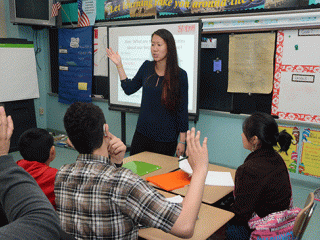In Integrated Co-Teaching (ICT) classes, the focus is on the group of students with disabilities recommended for the service rather than the individual students. Students in ICT classes are intentionally grouped together based on similarity of need for the purpose of receiving specially-designed instruction. Different or additional services should be considered for students with needs that are not common to the group. Marilyn Friend, consultant to the NYCDOE on team teaching, identifies class composition as one of the "top ten" issues that must be directly addressed by school administrators.
According to the state, the determination of whether integrated co-teaching is an appropriate recommendation for an individual student with a disability should be made in consideration of, but not limited to the following factors:
- the classes in which integrated co-teaching match to the student’s needs;
- the extent of special education services the individual student needs to access, participate and progress in the general education curriculum;
- the similarity of needs of the other students with disabilities in the class;
- the potential effect of the class size on the student’s learning needs;
- any potential benefits and harmful effects such services might have for the student or on the quality of services that he or she needs; and
- whether the extent of the environmental modifications or adaptations and the human or material resources needed for the student will consistently detract from the opportunities of other students in the group to benefit from instruction.
Stated another way, Integrated Co-Teaching may not be an appropriate service for a student with a disability if the student:
- requires so much of the teachers’ time that the teachers cannot give adequate attention to the needs of other students in the classroom, and/or
- the student is so disruptive in the general education classroom that the education of the student or other students is significantly impaired, and/or
- the student requires the curriculum to be modified so significantly that it bears little relation to the instruction in the classroom.
There is no regulatory maximum number of non-disabled students in an integrated co-teaching class. However, the number of non-disabled students should be more than or equal to the number of students with disabilities in the class in order to ensure the level of integration intended by this program option. An important consideration in determining the number of students with disabilities and non-disabled students on an integrated class roster is that the ratio must not result in a de facto segregated class which would undermine the philosophy of inclusive practices.
